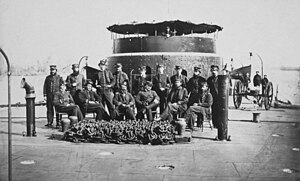USS Patapsco (1862)
 Pencil sketch of USS Patapsco
| |
| History | |
|---|---|
| Name | USS Patapsco |
| Builder | Harlan & Hollingsworth |
| Laid down | Unknown |
| Launched | 27 September 1862 |
| Commissioned | 2 January 1863 |
| Stricken | 1865 (est.) |
| Fate | Sunk by mine on 15 January 1865 |
| General characteristics | |
| Class and type | Passaic-class ironclad monitor |
| Displacement | 1,875 long tons (1,905 t) |
| Length | 241 ft (73 m) |
| Beam | 46 ft (14 m) |
| Draft | 10 ft 10 in (3.30 m) |
| Installed power | 320 ihp (240 kW) |
| Propulsion |
|
| Speed | 6 kn (6.9 mph; 11 km/h) |
| Complement | 105 officers and enlisted |
| Armament | 1 × 15 in (380 mm) smoothbore gun, 1 × 8 in (200 mm) Parrott rifle |
| Armor | |
| Notes | Armor is iron. |
USS Patapsco was a Passaic-class ironclad monitor in the United States Navy during the American Civil War. She was named for the Patapsco River in Maryland.
Built in Wilmington, Delaware
[edit]Patapsco was the fourth U.S. Navy ship to bear that name. She was built by Harlan & Hollingsworth, Wilmington, Delaware; launched on 27 September 1862; and commissioned on 2 January 1863, Commander Daniel Ammen in command.
Civil War service
[edit]Assigned to the South Atlantic blockade
[edit]Assigned to the South Atlantic Blockading Squadron, she took part in a bombardment of Fort McAllister on 3 March. On 7 April, Patapsco joined eight other ironclads in a vigorous attack on Fort Sumter, and received 47 hits from Confederate gunfire during that day.

Beginning in mid-July, she began her participation in a lengthy bombardment campaign against Charleston's defending fortifications. This led to the capture of Fort Wagner in early September. Fort Sumter was reduced to a pile of rubble, but remained a formidable opponent.
In November 1863, Patapsco tested a large obstruction-clearing explosive device that had been devised by John Ericsson. Remaining off South Carolina and Georgia during much of 1864 and into 1865, the monitor — or her boat crews — took part in a reconnaissance of the Wilmington River, Georgia, in January 1864 and helped capture or destroy enemy sailing vessels in February and November of that year.
Sunk by a mine
[edit]On 15 January 1865, while participating in obstruction clearance operations in Charleston Harbor, Patapsco struck a Confederate mine and sank, with 75 lost. The ship's Executive Officer, Lieutenant William T. Sampson was one of a handful of survivors.
References
[edit] This article incorporates text from the public domain Dictionary of American Naval Fighting Ships. The entry can be found here.
This article incorporates text from the public domain Dictionary of American Naval Fighting Ships. The entry can be found here.- Additional technical data from Gardiner, Robert (1979). Conway's All the World's Fighting Ships 1860–1905. Conway Maritime Press. p. 120. ISBN 0-85177-133-5.
External links
[edit]- Passaic-class monitors
- Ships built by Harlan and Hollingsworth
- 1862 ships
- Ships of the Union Navy
- American Civil War monitors of the United States
- American Civil War patrol vessels of the United States
- Shipwrecks of the Carolina coast
- Shipwrecks of the American Civil War
- Maritime incidents in January 1865
- Ships sunk by mines
